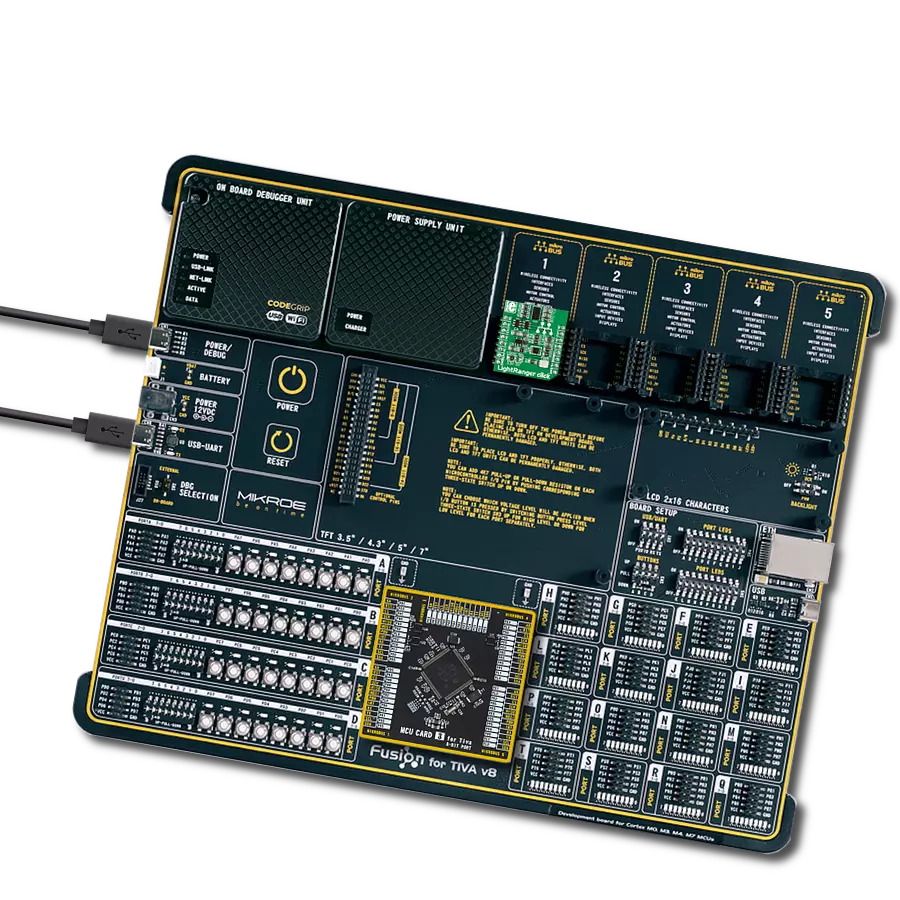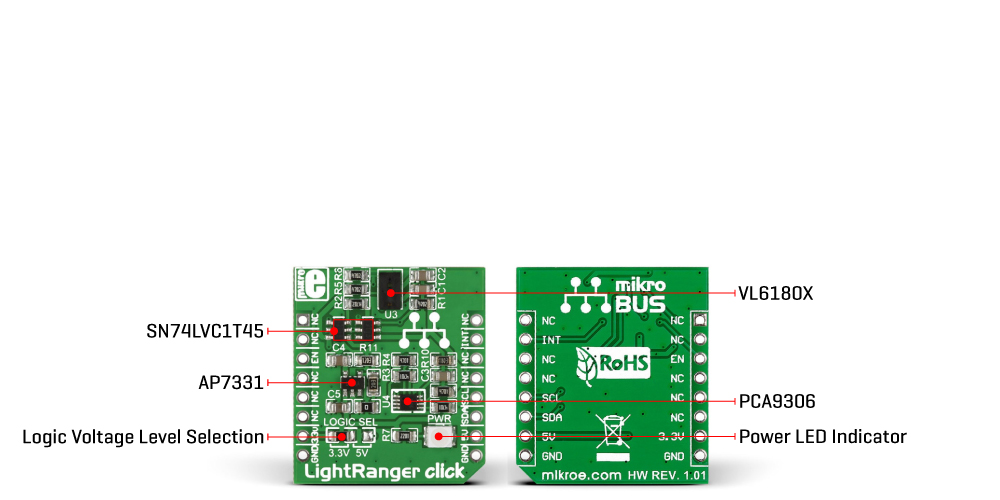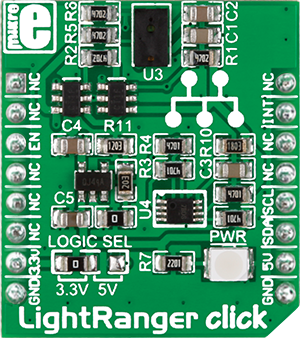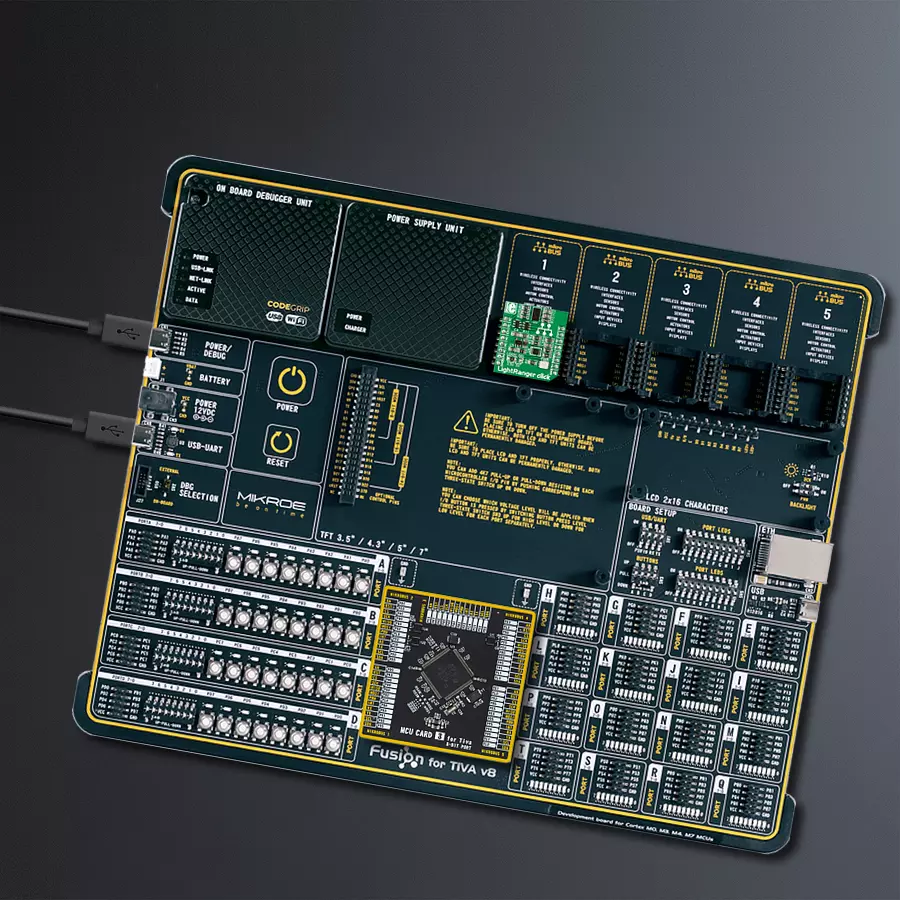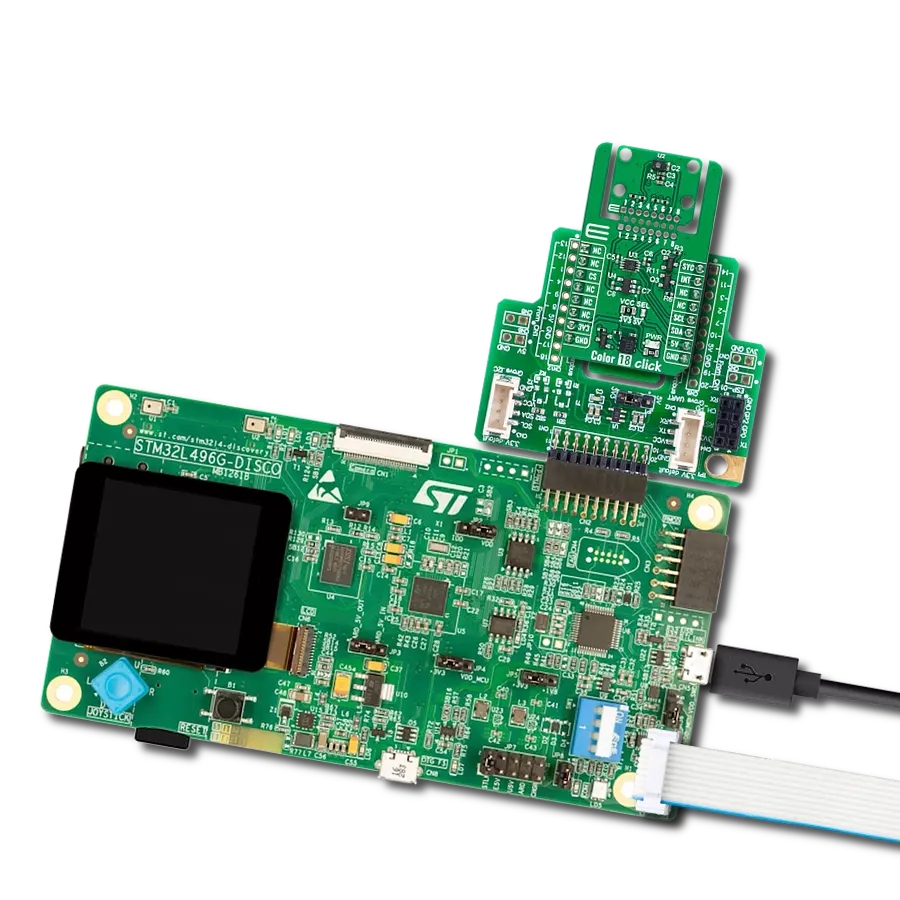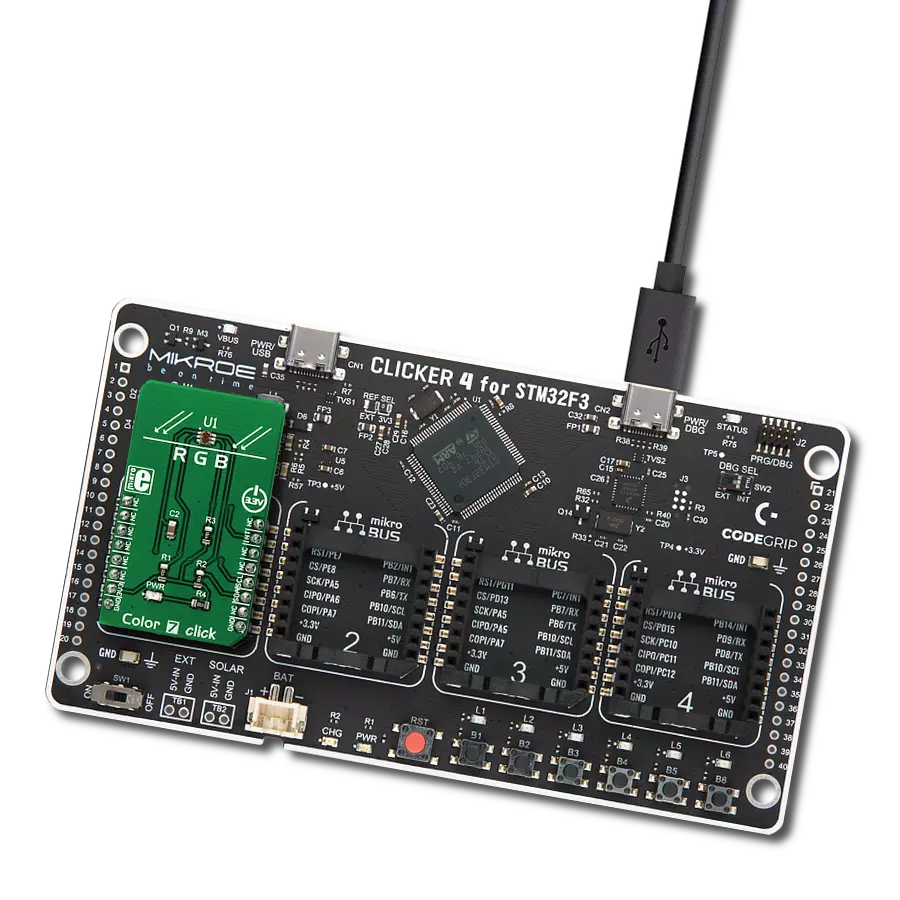Achieve precise distance measurements to enhance decision-making and control.
A
A
Hardware Overview
How does it work?
LightRanger Click is based on the VL6180X, a time-of-flight distance-ranging sensor from STMicroelectronics that combines proximity-ranging and ambient light-level measurement capabilities into a single package. The VL6180X is based on ST’s patented FlightSense™ technology, which allows absolute distance to be measured independently of target reflectance. Instead of estimating the distance by measuring the amount of light reflected from the object (which is significantly influenced by color and surface), the VL6180X precisely measures the time the light takes to travel to the nearest object and reflect back to the sensor up to 10cm (ranging beyond 10cm is dependent on conditions). Combining an IR emitter, a range sensor, and an ambient light sensor in a three-in-one package, the VL6180X is
designed for low-power operation and saves the end-user optical and mechanical design optimizations. This board can also measure the intensity of light with which it is illuminated up to 100klux. The VL6180X does not need a specific Power-Up sequence but requires a voltage of 2.8V for its VCSEL and power supply block to work correctly. Therefore, a small regulating LDO, the AP7331, provides a 2.8V out of chosen mikroBUS™ power rail. LightRanger Click communicates with MCU using the standard I2C 2-Wire interface with a maximum clock frequency of 400kHz, which is fully adjustable through software registers. Since the sensor for operation requires a power supply of 2.8V, this Click board™ also features the PCA9306 and SN74LVC1T45 voltage-level translators. The I2C interface bus lines are routed to the voltage-level
translators, allowing this Click board™ to work properly with both 3.3V and 5V MCUs. Also, it can be turned ON or OFF through the EN pin routed to the CS pin of the mikroBUS™ socket; hence, offering a switch operation to place the VL6180X in a hardware standby state and uses an interrupt pin, the INT pin of the mikroBUS™ socket, used for measurement ready and threshold interrupts. This Click board™ can operate with either 3.3V or 5V logic voltage levels selected via the LOGIC SEL jumper. Therefore, both 3.3V and 5V MCUs can use the communication lines. Also, this Click board™ comes equipped with a library containing easy-to-use functions and an example code that can be used as a reference for further development.
Features overview
Development board
Fusion for TIVA v8 is a development board specially designed for the needs of rapid development of embedded applications. It supports a wide range of microcontrollers, such as different 32-bit ARM® Cortex®-M based MCUs from Texas Instruments, regardless of their number of pins, and a broad set of unique functions, such as the first-ever embedded debugger/programmer over a WiFi network. The development board is well organized and designed so that the end-user has all the necessary elements, such as switches, buttons, indicators, connectors, and others, in one place. Thanks to innovative manufacturing technology, Fusion for TIVA v8 provides a fluid and immersive working experience, allowing access
anywhere and under any circumstances at any time. Each part of the Fusion for TIVA v8 development board contains the components necessary for the most efficient operation of the same board. An advanced integrated CODEGRIP programmer/debugger module offers many valuable programming/debugging options, including support for JTAG, SWD, and SWO Trace (Single Wire Output)), and seamless integration with the Mikroe software environment. Besides, it also includes a clean and regulated power supply module for the development board. It can use a wide range of external power sources, including a battery, an external 12V power supply, and a power source via the USB Type-C (USB-C) connector.
Communication options such as USB-UART, USB HOST/DEVICE, CAN (on the MCU card, if supported), and Ethernet is also included. In addition, it also has the well-established mikroBUS™ standard, a standardized socket for the MCU card (SiBRAIN standard), and two display options for the TFT board line of products and character-based LCD. Fusion for TIVA v8 is an integral part of the Mikroe ecosystem for rapid development. Natively supported by Mikroe software tools, it covers many aspects of prototyping and development thanks to a considerable number of different Click boards™ (over a thousand boards), the number of which is growing every day.
Microcontroller Overview
MCU Card / MCU
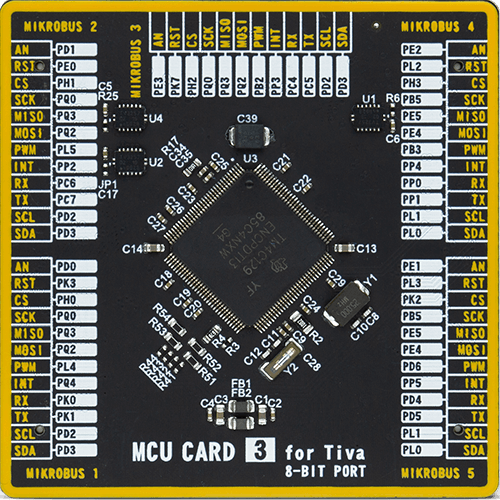
Type
8th Generation
Architecture
ARM Cortex-M4
MCU Memory (KB)
1024
Silicon Vendor
Texas Instruments
Pin count
128
RAM (Bytes)
262144
Used MCU Pins
mikroBUS™ mapper
Take a closer look
Click board™ Schematic

Step by step
Project assembly
Track your results in real time
Application Output
1. Application Output - In Debug mode, the 'Application Output' window enables real-time data monitoring, offering direct insight into execution results. Ensure proper data display by configuring the environment correctly using the provided tutorial.

2. UART Terminal - Use the UART Terminal to monitor data transmission via a USB to UART converter, allowing direct communication between the Click board™ and your development system. Configure the baud rate and other serial settings according to your project's requirements to ensure proper functionality. For step-by-step setup instructions, refer to the provided tutorial.

3. Plot Output - The Plot feature offers a powerful way to visualize real-time sensor data, enabling trend analysis, debugging, and comparison of multiple data points. To set it up correctly, follow the provided tutorial, which includes a step-by-step example of using the Plot feature to display Click board™ readings. To use the Plot feature in your code, use the function: plot(*insert_graph_name*, variable_name);. This is a general format, and it is up to the user to replace 'insert_graph_name' with the actual graph name and 'variable_name' with the parameter to be displayed.

Software Support
Library Description
This library contains API for LightRanger Click driver.
Key functions:
lightranger_write_byte- This function writes a byte of data to given addresslightranger_get_ambiant_light- This function reads register and calculates the light level in luxlightranger_get_distance- This function reads range result from register.
Open Source
Code example
The complete application code and a ready-to-use project are available through the NECTO Studio Package Manager for direct installation in the NECTO Studio. The application code can also be found on the MIKROE GitHub account.
/*!
* \file
* \brief LightRanger Click example
*
* # Description
* This application measures and calculates ambient light intensity and distance
* from the sensor, and then logs the results.
*
* The demo application is composed of two sections :
*
* ## Application Init
* Initialization driver for sensor Vl6180X and stars logging to terminal.
*
* ## Application Task
* Measures and calculates ambient light intensity and distance from sensor,
* when the distance is changed log is updated,
* results are being sent to the Usart Terminal where you can track their changes.
* All data logs on usb uart for approximately every 1 sec when the data value changes.
*
*
* \author MikroE Team
*
*/
// ------------------------------------------------------------------- INCLUDES
#include "board.h"
#include "log.h"
#include "lightranger.h"
// ------------------------------------------------------------------ VARIABLES
static lightranger_t lightranger;
static log_t logger;
// ------------------------------------------------------ APPLICATION FUNCTIONS
void application_init ( void )
{
log_cfg_t log_cfg;
lightranger_cfg_t cfg;
/**
* Logger initialization.
* Default baud rate: 115200
* Default log level: LOG_LEVEL_DEBUG
* @note If USB_UART_RX and USB_UART_TX
* are defined as HAL_PIN_NC, you will
* need to define them manually for log to work.
* See @b LOG_MAP_USB_UART macro definition for detailed explanation.
*/
LOG_MAP_USB_UART( log_cfg );
log_init( &logger, &log_cfg );
log_info( &logger, "---- Application Init ----" );
// Click initialization.
lightranger_cfg_setup( &cfg );
LIGHTRANGER_MAP_MIKROBUS( cfg, MIKROBUS_1 );
lightranger_init( &lightranger, &cfg );
lightranger_default_cfg( &lightranger );
Delay_ms ( 1000 );
}
void application_task ( void )
{
uint8_t range_value;
float lux_value;
lightranger_start_single_shot_range_mode( &lightranger );
lightranger_poll_range( &lightranger );
lightranger_interrupts_clear( &lightranger );
range_value = lightranger_get_distance( &lightranger );
log_printf( &logger, "Proximity : %u mm\r\n", ( uint16_t ) range_value );
lux_value = lightranger_get_ambiant_light( &lightranger, LIGHTRANGER_CMD_GAIN_1X );
log_printf( &logger, "Ambient Light: %.2f lux\r\n", lux_value );
log_printf( &logger, "*******************************************\r\n" );
Delay_ms ( 500 );
}
int main ( void )
{
/* Do not remove this line or clock might not be set correctly. */
#ifdef PREINIT_SUPPORTED
preinit();
#endif
application_init( );
for ( ; ; )
{
application_task( );
}
return 0;
}
// ------------------------------------------------------------------------ END
Additional Support
Resources
Category:Optical
